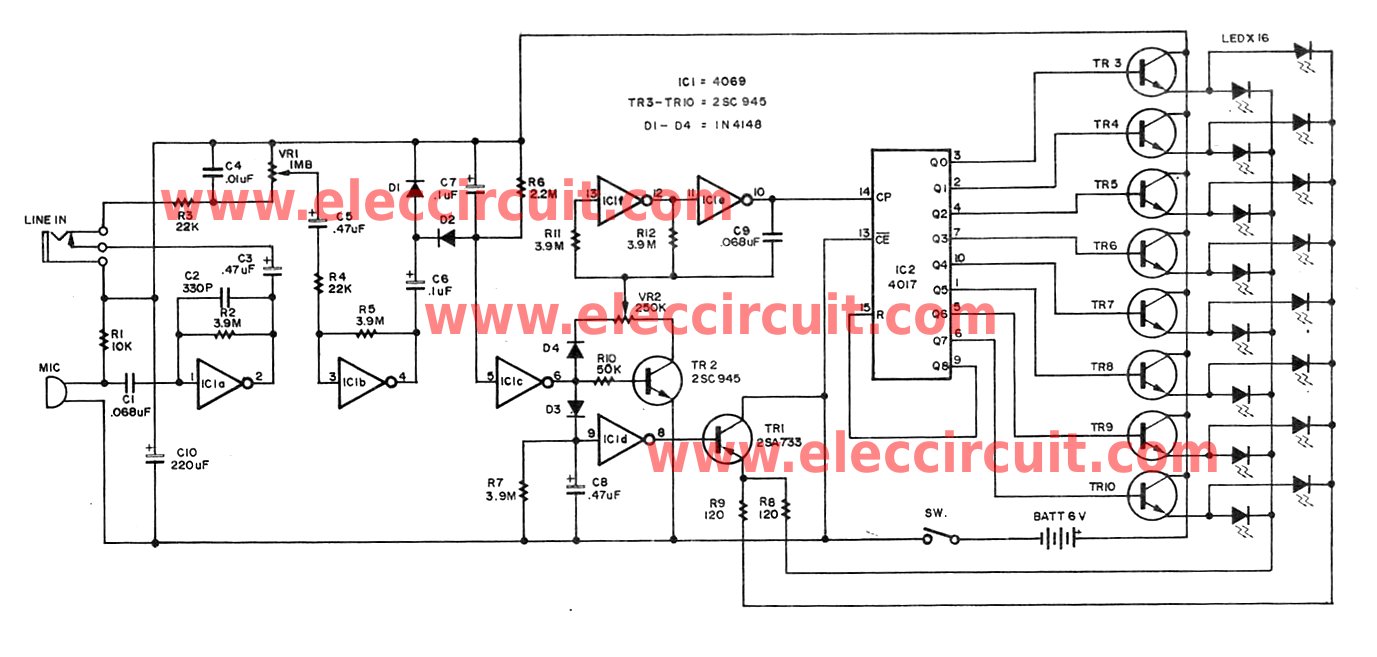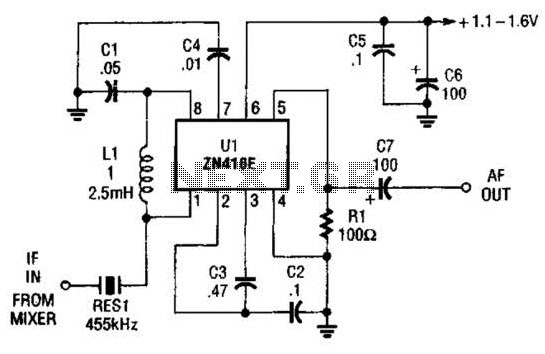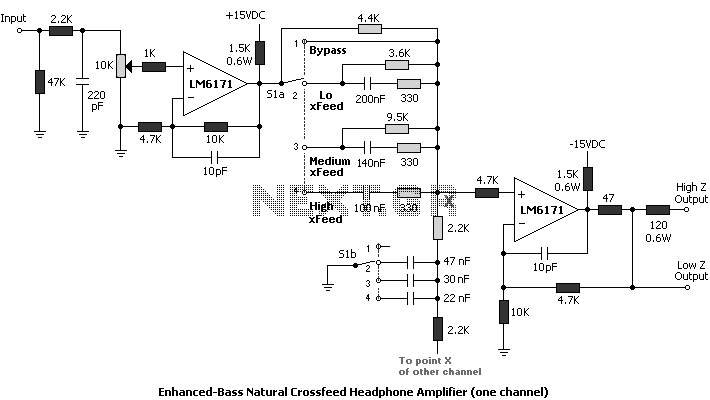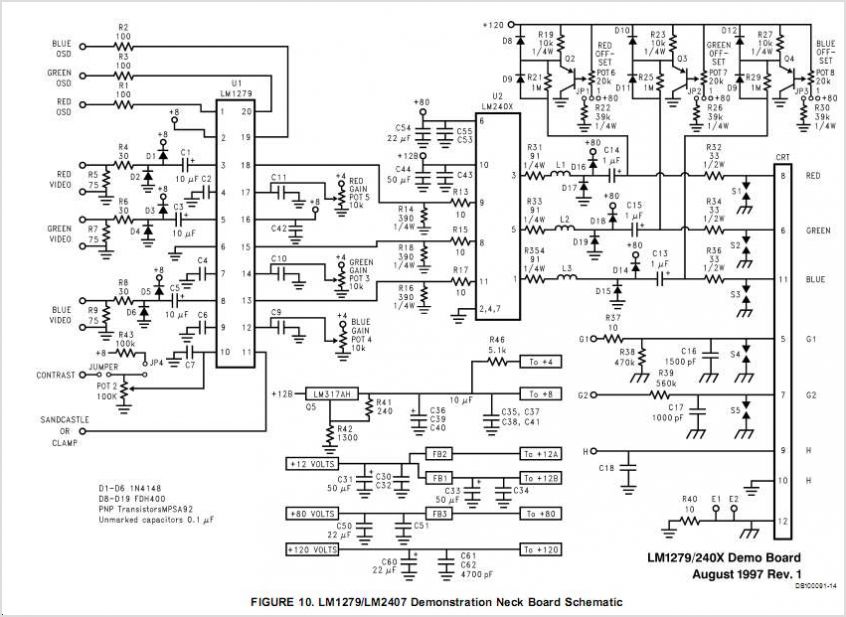
Universal Audio Line Amplifier
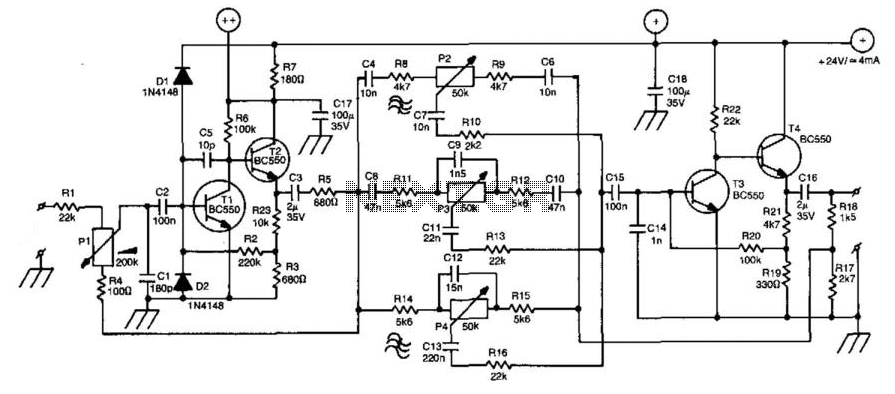
A line amplifier is a valuable component for matching line signals or increasing their levels. This functionality is essential during recording sessions or in public-address systems. Additionally, multiple line amplifiers can be combined to create a line mixer. The amplifier's input is designed to handle high voltages, while the output impedance remains low. The circuit employs a conventional design featuring two direct-current coupled amplification stages, separated by a threefold Baxandall tone control system. Notably, the volume control at the input connects its "cold" side to the output of the first amplifier instead of grounding it. This configuration allows the signal at that point to be out of phase with the input signal, enabling the amplifier to utilize negative feedback via PI. Consequently, the amplification is inversely related to the input signal magnitude, allowing for a broad range of input levels. The amplifier can even accept signals directly from the loudspeaker terminals of a power amplifier. The supply voltage for the amplifier is 24 V, with a current draw of approximately 4 mA. When multiple amplifiers are used together, as in a mixer panel, the various power supplies can be interconnected, eliminating the need to duplicate components such as capacitors C17 and C18, and resistor R7.
The line amplifier circuit is structured to enhance signal integrity and adaptability across various applications, particularly in audio processing environments. The high-voltage input design ensures robust handling of incoming signals, making it suitable for integration with other audio equipment, including power amplifiers and mixers. The low output impedance facilitates seamless connection to additional circuitry without significant signal loss or distortion.
The use of two stages of DC-coupled amplification allows for significant gain while maintaining stability and fidelity in signal reproduction. The threefold Baxandall tone control system provides users with the ability to adjust the tonal characteristics of the audio signal, enhancing the versatility of the amplifier in different acoustic settings. The unique configuration of the volume control not only aids in achieving a desirable output level but also contributes to the negative feedback mechanism that helps maintain linearity and dynamic range.
Power consumption is modest, with the amplifier drawing only 4 mA at 24 V, making it efficient for extended use in various applications. The option to interlink power supplies when utilizing multiple amplifiers simplifies the design and reduces the overall component count, allowing for a more streamlined and cost-effective setup in complex audio systems. This feature is particularly advantageous in professional audio environments where space and resources are at a premium.
Overall, the line amplifier serves as a critical component in modern audio systems, providing essential functionality for signal processing, level matching, and tonal adjustments, thereby enhancing the overall audio experience. A line amplifier is always a useful unit to have around, whether it is for matching a line signal or raising its level somewhat. This might be needed during a recording session or with a public-address system. Furthermore, a line mixer can be constructed from a number of these amplifiers. The input of the amplifier is high-voltage proof. The output impedance is low. The circuit is a conventional design: two dc-coupled stages of amplification are separated by a threefold Baxandall tone control system. The volume control at the input is conspicuous by having its "cold" side connected, not to ground, but to the output of the first amplifier.
Because the signal there is out of phase with the input signal, the amplifier obtains negative feedback via PI. The amplification is therefore inversely proportional to the magnitude of the input signal. Thus, it is possible for the amplifier to accept a wide range of input levels. It is quite possible to input a signal taken directly from the loudspeaker terminals of a power amplifier.
The supply voltage is 24 V. At that voltage, the amplifier draws a current of about 4 mA. If several amplifiers are used in conjunction (as, for instance, in a mixer panel), the various supplies (+ and + + in the diagram) can be interlinked. Capacitors C17 and C18, and resistor R7 don"t need to be duplicated in that case.
The line amplifier circuit is structured to enhance signal integrity and adaptability across various applications, particularly in audio processing environments. The high-voltage input design ensures robust handling of incoming signals, making it suitable for integration with other audio equipment, including power amplifiers and mixers. The low output impedance facilitates seamless connection to additional circuitry without significant signal loss or distortion.
The use of two stages of DC-coupled amplification allows for significant gain while maintaining stability and fidelity in signal reproduction. The threefold Baxandall tone control system provides users with the ability to adjust the tonal characteristics of the audio signal, enhancing the versatility of the amplifier in different acoustic settings. The unique configuration of the volume control not only aids in achieving a desirable output level but also contributes to the negative feedback mechanism that helps maintain linearity and dynamic range.
Power consumption is modest, with the amplifier drawing only 4 mA at 24 V, making it efficient for extended use in various applications. The option to interlink power supplies when utilizing multiple amplifiers simplifies the design and reduces the overall component count, allowing for a more streamlined and cost-effective setup in complex audio systems. This feature is particularly advantageous in professional audio environments where space and resources are at a premium.
Overall, the line amplifier serves as a critical component in modern audio systems, providing essential functionality for signal processing, level matching, and tonal adjustments, thereby enhancing the overall audio experience. A line amplifier is always a useful unit to have around, whether it is for matching a line signal or raising its level somewhat. This might be needed during a recording session or with a public-address system. Furthermore, a line mixer can be constructed from a number of these amplifiers. The input of the amplifier is high-voltage proof. The output impedance is low. The circuit is a conventional design: two dc-coupled stages of amplification are separated by a threefold Baxandall tone control system. The volume control at the input is conspicuous by having its "cold" side connected, not to ground, but to the output of the first amplifier.
Because the signal there is out of phase with the input signal, the amplifier obtains negative feedback via PI. The amplification is therefore inversely proportional to the magnitude of the input signal. Thus, it is possible for the amplifier to accept a wide range of input levels. It is quite possible to input a signal taken directly from the loudspeaker terminals of a power amplifier.
The supply voltage is 24 V. At that voltage, the amplifier draws a current of about 4 mA. If several amplifiers are used in conjunction (as, for instance, in a mixer panel), the various supplies (+ and + + in the diagram) can be interlinked. Capacitors C17 and C18, and resistor R7 don"t need to be duplicated in that case.
